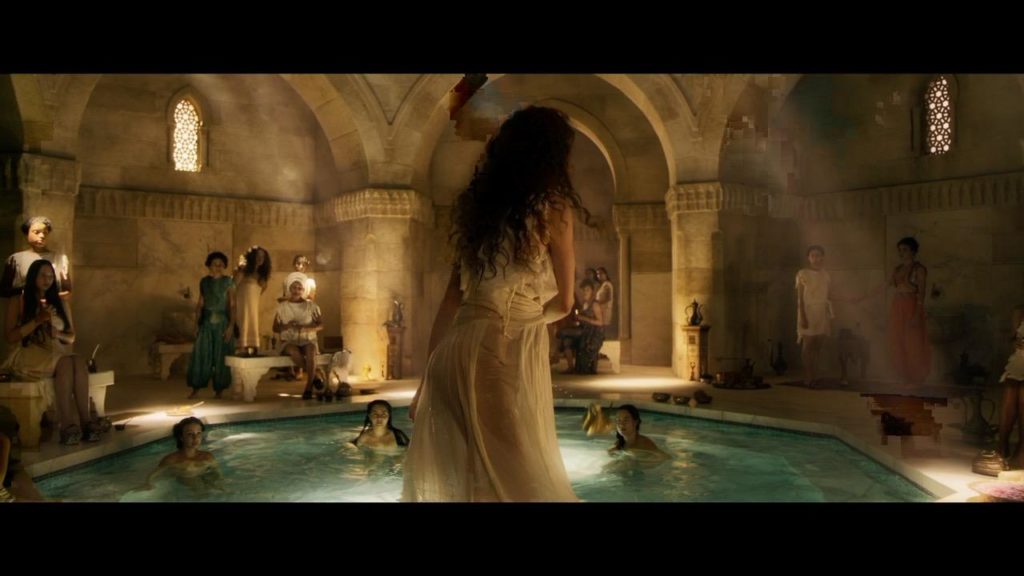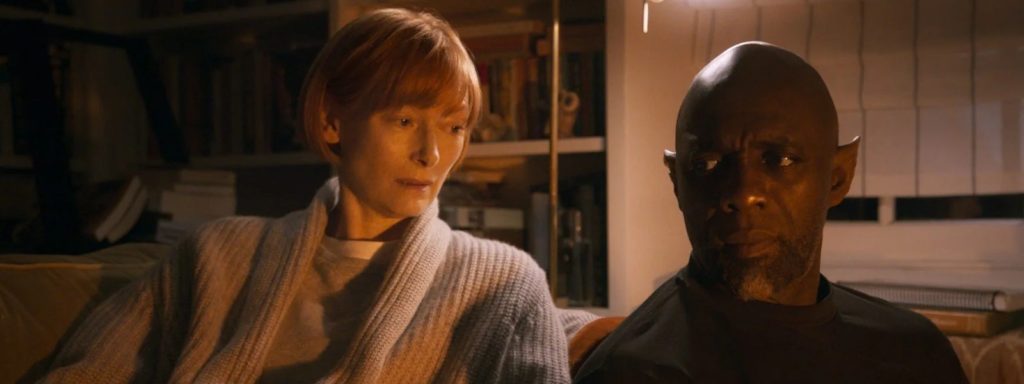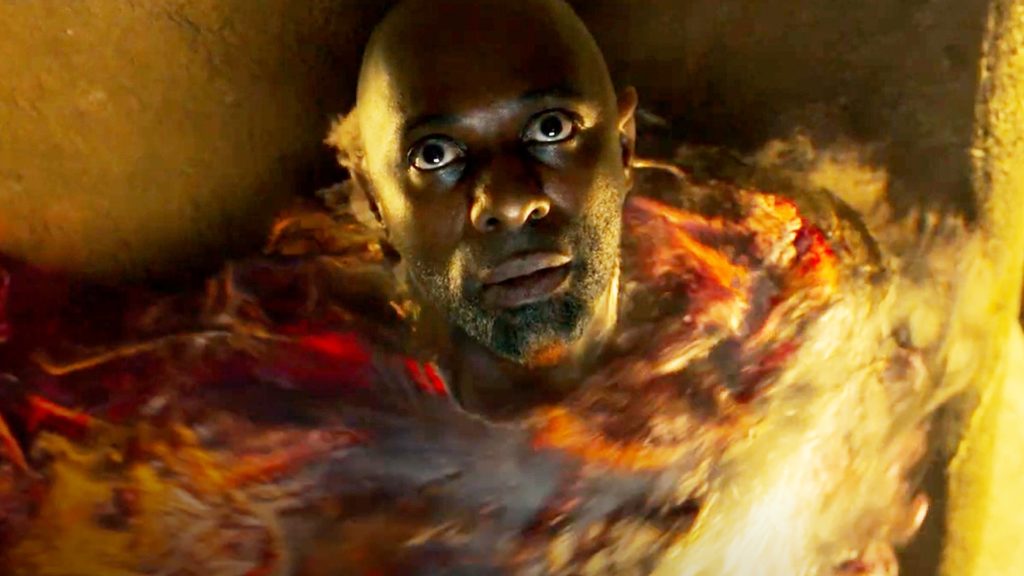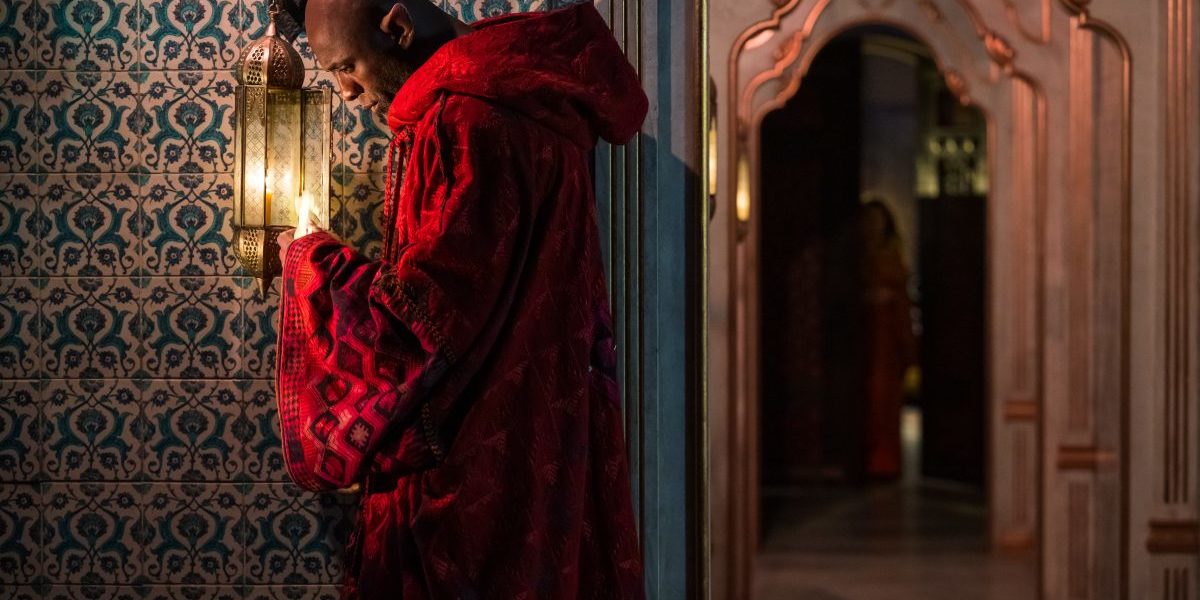Tilda Swinton Ain’t Never had a Friend Like Idris Elba
DIRECTED BY GEORGE MILLER/2022

The wishes of the many film fans pining for George Miller’s follow-up to his visceral sensation Mad Max: Fury Road has, after seven years, been granted. Now the question is, how magical is the result?
With co-leads Tilda Swinton (as an upper-class scholar) and Idris Elba as a Djinn whom she inadvertently releases from his captive bottle, Miller’s Three Thousand Years of Longing can’t be said to lack in its casting. The pair spend most of the film in conversation in her high-end hotel room in Istanbul with frequent jumps to his flashbacks detailing his unsuccessful attempts to break free of his ancient imprisonment curse. It turns out that despite the central allure of the Djinn’s offer for three very open-ended wishes, he is, on three different occasions in three different time periods, remarkably unable to get his subjects to run that gamut. True to the tale, the consequence of him not fulfilling the three wishes for whoever’s freed him is that he remains confined to the bottle. This has been his plight for 3000 years.
The flashback tales are epic and impressively ornate, full of detailed landscapes, dazzling palaces, and their many harems, hallways, and chambers. They feature an international array of interesting faces, including Aamito Lagum (as the Queen of Sheba), Burcu Gölgedar, Matteo Bocelli (as Prince Mustafa), Kaan Guldur (as Murad IV), and Jack Braddy (as Ibrahim). It is in these often-decadent sequences that Three Thousand Years of Longing earns its R rating, although its “decadence” looks very different from what one may assume. Per one prominent character’s much-indulged fetish of “corpulent women” (as they’re credited), Miller and company make a strikingly unapologetic statement that big is indeed beautiful.

Not everything on screen is quite so organic as all that. The film’s CGI, of which there is much, does not fare so well. Even Elba himself, disproportionately large (Lord of the Rings style) for portions of the film, sports a weird scaly blue digital lower half. The flashbacks are the film’s grand set pieces, big on storytelling ambition if perhaps shorter on conventional structure. With the all-too-familiar three act structure out the window, it’s anyone’s guess as to where things are ultimately headed. This is as fascinating as it can be challenging, which can’t be said to be a bad thing by any stretch. To be clear, Three Thousand Years of Longing never approaches a momentum that one would call “rapid”. If anything, it taxes our patience. But the burden for such taxing likely rests upon the audience, as the film is also never not fascinating.
Although Three Thousand Years of Longing (an adaptation of the short story “The Djinn in the Nightingale’s Eye” by A.S. Byatt) resonates as a true project of passion on every level, it certainly does seem as though Miller very deliberately set out to make something as 180-degrees opposite of Mad Max as possible. (Call it “George Miller’s Crossing”). His previous action extravaganza has a massive cast tearing across the desert at a hundred miles per hour; this has two inert characters talking in a hotel room. Mad Max has savage and brutal stakes; Three Thousand Years has a big mushy soft spot. Still, both are about emancipation to varying degrees. So too is Miller’s grandly underrated Babe: Pig in the City.
All these projects also share the filmmaker’s commitment to palatable visual dynamism. Consistently, Miller favors containing his action toward the center of the frame. The director can then cut as rapidly from thing to thing to thing as he chooses without taxing the audience members’ perception from one shot to the next. The eye can remain focused in a central zone of the frame, as it is not being tasked with darting all over to track what’s where. It makes all the difference in terms of alleviating the mental exhaustion that so many other less visually disciplined movies (particularly other action movies) inflict.

If there’s a directorial identification to be guessed at insofar as why Miller has been impassioned by this material to the point of cashing in his post-Fury Road cred to get it made (and one can’t imagine that studios were exactly lining up for this type of film, no matter who’s helming it), it probably has to do with the Djinn character. For several decades, Miller, as the creator and keyholder of Mad Max, has been one of those filmmakers in a position of fulfilling fan’s wishes. Yes, he exceeded the wildest dreams of many with The Road Warrior and Fury Road, but perhaps he’s felt a bit trapped? And now that he’s finally been “released” into a world of creative freedom, he finds himself faced with an already satiated post-Michael Bay audience, unsure of exactly what to ask for.
That’s, of course, entirely speculation. What is there on screen is a reoccurring thread about a more complex need for release, as in “tension & release”; as in “stress tension”. Beginning with Swinton, there’s at least a couple occasions of the camera moving in on a nervously tapping foot. Even for this character who claims assuredness in her supposed contentment, something is eating at her.

Unlike the perpetually recapping Djinn, details of Swinton’s character’s life are more sparse. We know that her beloved husband died some time ago, his precious belongings boxed up on a shelf in the basement. One can read in subsequent sexual unfulfillment, should that notion occur. It’s nothing tremendously overt in Longing, other than suppressed loneliness seems to be a point of connection for the two leads. And then there are other assorted details…. Is it a coincidence that the bottle containing Idris Elba resembles some sort of sex toy? Is it another coincidence that Swinton achieves the big release when she implements a rapidly vibrating electric toothbrush in her attempts to clean it? Thematically (and that’s all this is), this fits.
One could stand back and look at Three Thousand Years of Longing and state that it’s a comparatively mature piece alongside of his other work. Maybe that’s astute, maybe it’s rubbish- but the genie is out of the bottle now. Not everyone will find their bliss with Three Thousand Years of Longing. Fans simply hoping for another Fury Road-esque spectacle might well find themselves utterly denied. But perhaps they should reassess their values, and be careful what they wish for, as this unconventional tale has its own brand of lingering magic.


